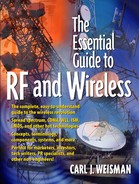Chapter 5. Circuits and Signals
This chapter ties together, literally, all the components discussed up to this point. Three different circuit technologies used to manufacture RF components are introduced: discrete, hybrid, and MMIC. Their differences are noted, as well as the reasons why one is chosen over another in a particular situation. The three are also viewed from the standpoint of both performance and cost impact. Additionally, this chapter covers three different component interconnection schemes: cable, waveguide, and traces. Once again, the reasons why one is chosen over another are pointed out.
This chapter also introduces you to two different circuit philosophies: lumped element and distributed. With these you will see how some RF components can actually be realized two different ways, the choice of which depends heavily on their frequency of intended use.
RF semiconductor devices are covered in detail, including the primary materials used in RF electronics and the two main devices used in all RF hardware: diodes and transistors. Also included is a discussion on integrated circuits, and their advantages and disadvantages when compared to other options.
This chapter also deals with the very complicated subject of modulation, which is the term used for combining the information signal with the carrier signal in wireless communications. The major modulation techniques are discussed, along with some of their variations. You also will learn of the role that digital technology has played in the evolution of the modulation schemes most prevalent in today's most sophisticated wireless systems.
